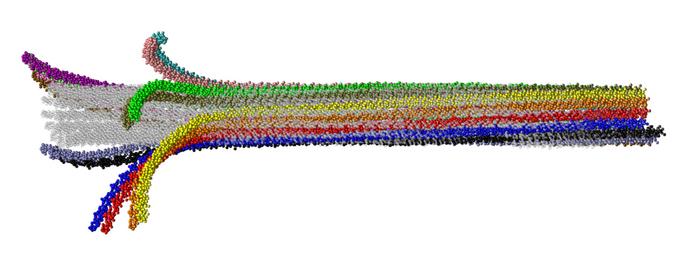In the intricate world of cellular biology, microtubules hold a crucial role as dynamic structures that enable various cellular functions, including cell division and transport. Comprised of protein subunits known as tubulin, microtubules are not mere passive scaffolds; they are structural polymers that undergo constant remodeling through polymerization and depolymerization. Recent advancements in computational simulations have shed light on the elusive mechanisms at the tips of these vital structures, offering insights into their behavior that have far-reaching implications for understanding neurodegenerative diseases and developing targeted cancer therapies.
The dynamic instability of microtubules is a defining characteristic of their function within cells. They exhibit a remarkable ability to rapidly grow and shrink, a process dictated by the state of the tubulin subunits. When tubulin binds to Guanosine-5′-triphosphate (GTP), it promotes microtubule growth. Conversely, the hydrolysis of GTP to Guanosine diphosphate (GDP) triggers instability, leading to rapid depolymerization. This cyclical process is fundamental to cell division, where microtubules orchestrate the separation of chromosomes in a process that is both finely tuned and crucial for genetic integrity.
Recent simulations conducted by researchers affiliated with the University of Chicago and the University of Utah have delved deeper into the behaviors exhibited at microtubule tips, the epicenters for growth and stability fluctuations. These sophisticated models employed state-of-the-art supercomputing resources to illuminate the differences in microtubule configurations depending on whether the end of the structure is in a GTP or GDP state. The findings reveal that the tips of microtubules do not behave as previously thought; they exhibit consistent splaying, irrespective of the nucleotide state, which poses significant questions regarding our understanding of microtubule dynamics.
Gregory Voth, a prominent figure in this research and a distinguished professor at the University of Chicago, highlights that this revolutionary perspective alters conventional assumptions regarding microtubule behavior. The use of high-performance computing not only accelerated simulation speeds but also enabled researchers to observe microtubule dynamics over unprecedented time scales, reaching up to 5.875 microseconds of molecular evolution. This extended timeframe proves vital in comprehending the complex interactions at the molecular level, allowing for a more exhaustive understanding of the roles these structures play in living organisms.
Through the integration of machine learning with advanced computational methods, the research team achieved a two-fold increase in the efficiency of their simulations. By leveraging large data sets generated by supercomputer processes like those on the Frontera system, researchers could model the intricate behaviors of microtubule tips under various conditions. Such computational strategies can now yield insights that provide a clearer picture of how microtubule dynamics affect cellular functions, potentially unlocking novel pathways for therapeutic interventions.
The collaborative research highlighted the need for high-performance computing resources, as Voth notes that without the computational power of systems like Frontera, their ambitious simulations would not have been feasible. The synergy between massive computational capabilities and machine learning has provided researchers with a powerful toolkit to access microtubule dynamics that were, until now, shrouded in mystery.
Additionally, these simulations yielded highly detailed structural data that illuminated conformational differences between GTP and GDP-bound microtubules. With this understanding, researchers can better analyze how microtubules interact with other cellular machinery, thereby enhancing our knowledge of fundamental biological processes, including the pathogenesis of neurodegenerative diseases like Alzheimer’s and Parkinson’s. The intricate dance of microtubules underlies crucial processes, including the transport of organelles and the maintenance of cell shape, making their study imperative in advancing both biological understanding and therapeutic development.
In light of this groundbreaking research, Voth and colleagues assert that their findings can pave the way for innovative drug development strategies. A deeper comprehension of microtubule dynamics could lead to therapeutic avenues targeting their stability and behavior, particularly in cancer, where aberrant cell division is a hallmark trait. Understanding how to manipulate microtubule dynamics could revolutionize cancer treatment approaches by minimizing harmful side effects while enhancing efficacy, providing hope for improved patient outcomes.
As the field of computational biology continues to evolve, studies like these emphasize the necessity of interdisciplinary collaboration between computational scientists and biologists. By merging cutting-edge technologies with traditional experimental approaches, researchers can unlock a wealth of information that has the potential to redefine scientific paradigms. The implications of this work extend far beyond mere academic curiosity, with the potential to reshape our approach to treating diseases that afflict millions worldwide.
Ultimately, this research represents a monumental step forward in our comprehension of cellular biology. It challenges long-held beliefs about microtubule behavior, utilizing advanced simulations to provide a refined understanding of the microscopic world underpinning cellular functions. These discoveries could very well represent the cornerstone for future studies, paving the way for a new era of molecular science where computational power and biological insight converge in pursuit of fundamental answers to some of life’s most complex questions.
In conclusion, the exploration of microtubule dynamics offers profound insights into the microscopic orchestration of cellular machinery. The interplay between molecular simulation and machine learning creates a powerful narrative that not only advances our understanding of biological systems but also offers tangible pathways for future therapeutic developments. As we continue to unravel the complexities of life at the molecular level, the potential for groundbreaking discoveries remains limitless.
Subject of Research: Microtubule stability and dynamics
Article Title: Data-driven equation-free dynamics applied to many-protein complexes: The microtubule tip relaxation
News Publication Date: January 16, 2025
Web References: Link to the research study
References: Biophysical Journal
Image Credits: Gregory Voth, University of Chicago
Keywords: Microtubules, cellular dynamics, computational biology, machine learning, neurodegenerative diseases, cancer treatment, molecular simulations.




